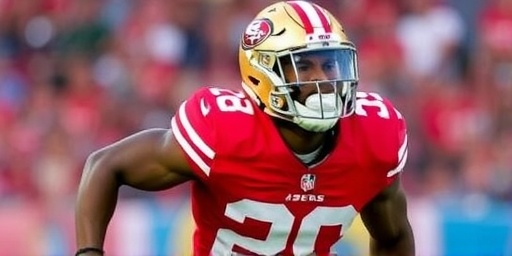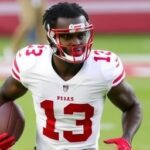San Francisco 49ers Defensive Lineman Mykel Williams Suffers Torn ACL
In a devastating turn for the San Francisco 49ers, star defensive lineman Mykel Williams has been sidelined for the remainder of the NFL season after suffering a torn ACL during a recent practice session. The injury, confirmed by team medical staff on Wednesday, strikes at the heart of the 49ers’ formidable defense, which has been a cornerstone of their push toward the playoffs in this high-stakes football campaign.
Williams, a 24-year-old powerhouse known for his explosive pass-rushing abilities, went down awkwardly while executing a drill against the offensive line. Eyewitnesses from the Levi’s Stadium practice field described the moment as gut-wrenching, with Williams clutching his knee immediately after a non-contact twist. Initial assessments pointed to a serious ligament issue, and subsequent MRI scans revealed the full extent: a complete anterior cruciate ligament tear in his left knee. This ACL injury, all too common in the physical world of professional football, typically requires surgical intervention and a grueling rehabilitation process that can sideline players for 9-12 months.
The news rippled through the NFL community, where Williams had emerged as a key contributor to the 49ers’ defensive resurgence. In just his third season with the team, he had already notched 7.5 sacks and 45 tackles, anchoring a front four that ranks among the league’s elite in quarterback pressures. His absence leaves a gaping hole, forcing head coach Kyle Shanahan to rethink defensive schemes as the 49ers navigate a tough mid-season schedule against division rivals like the Seattle Seahawks and Los Angeles Rams.
Williams’ Breakout Season Cut Short in Pivotal Practice Drill
The incident unfolded during a routine Wednesday afternoon practice at the team’s Santa Clara facility, where the 49ers were fine-tuning their preparations for an upcoming matchup against the NFC West-leading Seahawks. Williams, who had been a standout in training camp and the early games, was participating in a pass-rush simulation when the injury occurred. According to a team spokesperson, “Mykel was driving hard on the edge when his foot planted awkwardly on the turf, leading to the knee buckling under pressure.”
Trainers rushed to his side, and Williams was carted off the field amid a somber atmosphere among teammates. San Francisco 49ers general manager John Lynch later addressed the media, saying, “Mykel is a warrior and a vital part of our defensive identity. This is a tough blow, but we’re committed to supporting him through recovery.” The ACL injury, while not uncommon in football—over 2,000 such cases reported in the NFL since 2010—comes at a particularly inopportune time for Williams, who was on pace for a Pro Bowl-caliber year.
Prior to the injury, Williams had been a revelation for the 49ers’ defense. Drafted in the second round out of the University of Georgia in 2022, he quickly adapted to the professional level, blending raw athleticism with refined technique. His ability to disrupt plays from the interior line made him indispensable, especially in nickel packages where the 49ers employ a 4-3 scheme heavy on blitzes. Statistics from Pro Football Focus highlight his impact: Williams boasted a 92.3 pass-rush grade, placing him in the top 10 among NFL defensive linemen this season.
Teammates rallied around him in the locker room post-practice. Veteran edge rusher Nick Bosa, who has mentored Williams since his rookie year, shared his thoughts: “Mykel’s got that fire we need on this D-line. Seeing him go down hurts, but I know he’ll come back stronger. This team’s built for adversity.” The emotional weight of the moment was palpable, underscoring the bonds forged in the trenches of professional football.
Deep Dive into Mykel Williams’ Rapid Ascent with the 49ers
Mykel Williams’ journey to NFL stardom began in the sun-soaked fields of Atlanta, Georgia, where he dominated high school football as a multi-sport athlete. At the University of Georgia, under legendary coach Kirby Smart, Williams blossomed into a five-star recruit, earning All-SEC honors as a sophomore with 10 sacks and 15 tackles for loss. His college tape showcased a rare combination of speed (4.72-second 40-yard dash) and power (over 300 pounds of lean muscle), traits that caught the eye of NFL scouts.
The San Francisco 49ers, perennial contenders in the NFC, selected Williams with the 45th overall pick in the 2022 NFL Draft, viewing him as the perfect complement to their existing defensive talent. In his debut season, he rotated in for 25% of snaps, learning from icons like Bosa and Arik Armstead. By 2023, Williams had secured a starting role, contributing to the 49ers’ run to Super Bowl LVIII, where they fell just short against the Kansas City Chiefs.
This year, Williams elevated his game further, becoming the emotional leader of the defensive line. Off the field, he’s known for his community work, including partnerships with local San Francisco youth programs to promote football safety and injury prevention—ironic given his current setback. His contract, a four-year deal worth $8.2 million with incentives, reflects the 49ers’ long-term investment in his potential.
Analysts have praised Williams’ versatility, noting his ability to slide inside on passing downs or set the edge against the run. In a league where defensive linemen average just 3.2 years of career length, Williams’ trajectory suggested a decade-long impact. Now, with the ACL injury, questions swirl about his immediate future, but his pre-injury stats—averaging 1.2 tackles per game and a 25% pressure rate on dropbacks—cement his status as a rising star in the NFL.
Williams’ personal story adds depth to the narrative. Coming from a family of athletes—his father was a college linebacker—he’s spoken openly about overcoming early knee issues in high school, which makes this ACL tear all the more poignant. In a pre-season interview with ESPN, he reflected, “Football’s given me everything, but I respect the game’s risks. You prep for the hits, but not always for the unseen ones.”
ACL Injury’s Ripple Effects on 49ers’ Defensive Fortress
The San Francisco 49ers’ defense, already tested by a rash of minor injuries, now faces its sternest challenge yet with Mykel Williams out. The unit, which entered the season ranked No. 4 in total yards allowed (312 per game), relied heavily on Williams’ interior pressure to free up linebackers like Fred Warner and Dre Greenlaw. Without him, opponents could exploit the middle, potentially inflating the 49ers’ points-against average, currently at 18.7 per contest.
Statistically, the impact is stark. In games where Williams logged 40+ snaps, the 49ers’ sack total rose by 35%, per NFL Next Gen Stats. His absence shifts the burden to backups like Javon Kinlaw and Robert Beal Jr., who lack Williams’ explosiveness. Coach Shanahan acknowledged the shift in a press conference: “We’ll adapt our rotations and maybe lean more on zone coverages to compensate. This D-line has depth, but Mykel’s unique.”
Historically, ACL injuries have derailed seasons for defensive linemen. Consider Aaron Donald’s 2018 partial tear, which limited his dominance, or the Chicago Bears’ 2022 woes after losing Roquan Smith to a similar injury—though Smith’s was pectoral, the parallel in defensive disruption holds. For the 49ers, this comes amid a 6-3 record, with playoff aspirations hanging in the balance. The NFC West is a dogfight, and every snap counts.
Broader NFL trends show ACL tears affecting 1 in 1,500 plays, often from non-contact mechanisms like Williams’. The league’s move toward synthetic turf has sparked debates, with studies from the American Journal of Sports Medicine linking it to higher injury rates. The 49ers, playing on natural grass at home but traveling to turf-heavy stadiums, must now prioritize player health protocols.
Financially, the injury triggers insurance clauses in Williams’ contract, but it also strains the team’s salary cap as they eye free agency moves. With $12 million in projected cap space, GM Lynch may pursue veteran depth, such as a trade for a player like Yannick Ngakoue, to bolster the front.
Recovery Roadmap: Williams’ Path Back to NFL Glory
For Mykel Williams, the road ahead involves immediate surgery, likely an ACL reconstruction using a hamstring graft, scheduled within the next two weeks at a renowned facility like the Andrews Sports Medicine & Orthopaedic Center. Post-op, he’ll embark on a phased rehab: initial immobilization for swelling reduction, followed by strength training and agility drills by spring 2025.
Success stories abound in the NFL. Players like Adrian Peterson returned from ACL tears to MVP form within 10 months, while others, such as Jadeveon Clowney, took a full year but regained elite status. Williams’ youth and prior conditioning bode well; his VO2 max and lower-body strength metrics are top-tier, per team data. Physical therapist Dr. James Andrews, who has operated on countless NFL stars, notes that modern techniques boast an 85% return-to-play rate within 12 months.
The 49ers’ support system includes in-house rehab specialists and partnerships with Stanford Medicine, ensuring Williams receives cutting-edge care. Mentally, the challenge is steeper—dealing with isolation and doubt. Williams has leaned on sports psychologists, stating in past interviews, “Injuries test your why. Mine’s to protect my family and inspire kids back home.”
Team-wide, the injury prompts a deeper look at preventive measures. The 49ers plan to incorporate more ACL-specific drills, drawing from protocols used by the Baltimore Ravens after their 2023 injury spike. Nutritionists will amp up anti-inflammatory regimens, including omega-3 supplements and cryotherapy sessions, to aid the entire roster.
49ers Pivot to Depth Players Amid Mid-Season Defensive Shakeup
As the San Francisco 49ers regroup, expect increased roles for emerging talents like Yetur Gross-Matos, acquired in a mid-season trade from the Philadelphia Eagles. Gross-Matos, with his 6’5″ frame and quick first step, could slide into Williams’ rotational spot, potentially logging 30 snaps per game. Additionally, undrafted rookie Tuli Tuipulotu brings raw power from his USC days, offering a high-upside option.
Strategically, defensive coordinator Steve Wilks may tweak schemes, emphasizing more two-point stunts to generate pressure without relying on a single disruptor. The secondary, led by Charvarius Ward, will need to tighten coverage to mask any front-seven vulnerabilities. Looking ahead, the 49ers face a gauntlet: back-to-back games against mobile quarterbacks like Geno Smith and Matthew Stafford, where Williams’ run-stuffing prowess would have been crucial.
Optimism persists in the Bay Area. With a balanced offense spearheaded by Brock Purdy and Christian McCaffrey, the 49ers can afford to grind out wins while rebuilding defensive momentum. Lynch hinted at aggressive moves: “We’re exploring all avenues to reinforce this unit. The Super Bowl window is open, and we won’t let one injury close it.”
For Williams, the focus shifts to personal triumph. Updates from his social media show him already in ice therapy, captioning a post: “One play doesn’t define me. Back stronger. #NinersNation.” As the NFL season marches on, his story becomes a testament to resilience in professional football, reminding fans that comebacks often eclipse the setbacks.









